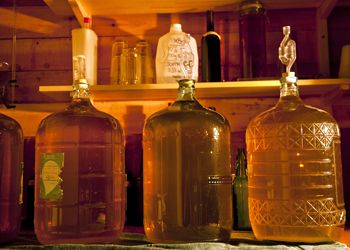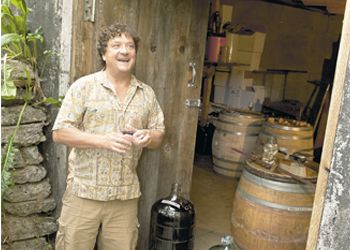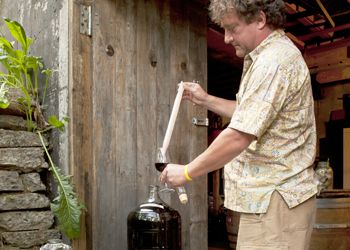It Takes a Village



By Janet Eastman
Jim Kurtz is an accidental winemaker. A little over a year ago, Kurtz and his wife Tina moved to the Rogue Valley from San Diego County with no intention of taking on a new hobby. But before boxes were unpacked and his collection of wine books was arranged on shelves, he met a new neighbor who made wine at home for fun. One sip put Kurtz on a fast-paced course. He zoomed from wine appreciator to a purple-fingered home producer.
At the tail-end of the harvest season last year, he bought grapes from a hobby grape grower and starter equipment at a home winemaking store. He then crushed, babied and bottled 10 cases of what is now being labeled Kurtz Cellars Tempranillo and Kurtz Cellars Syrah.
In September this year, he took control of an orphaned vineyard, which was planted a dozen years ago by another hobby vintner. So Kurtz, a full-time investment advisor and part-time winemaker, is now a grape grower with a vineyardette.
In contrast, Cliff Deveney, a surgeon with Oregon Health and Science University, has been buying grapes and making wine to drink at home for so long he no longer calls it a hobby, but a lifestyle. “After 40 years of doing this, I’m accustomed to the harvest work, the crush, the press, the fermentation and the smells in the basement,” he says. “I don’t know what I would do if I didn’t do it.”
And Francois Serrou, a dental hygienist and home winemaker since 1999, says he’s not too proud to quiz professional vintners who land in his dental chair about issues he’s encountering with Pinot Noir aging in his Portland basement. “With a sharp dental tool in my hand, they’ll tell me anything,” he jokes. “I say to them, ‘My wine stinks. What’s going on?’ And they give me tricks and run tests for me.”
Amateur winemakers. Hobby growers. Home supply kits. Basements cleaned up and transformed into wine cellars. Yes, home winemaking is catching on.
Gallup polls have long showed that wine is second only to beer as Americans’ alcohol of choice. In Oregon and other states, an increase in wineries, wine-related events and farmland striped with vineyards has lead to more curiosity about how the stuff is made.
That translates to this: The number of books, magazines, blogs, websites, supply stores, consultants, clubs, classes and contests focused on amateur winemaking has ballooned in the last decade. WineMaker magazine has seen its readership double to more than 100,000 hobbyists across the U.S. who are looking to troubleshoot problematic juice, learn the protocol of hosting garage tastings and read about fellow “cellar dwellers.”
Some home vintners say they’re saving money by making their own wine. But Deveney, who takes the high road by buying quality grapes and storing his reds in French oak for more than a year, can’t imagine economics being a factor. When comparing inexpensive wine available from around the world, he says, “You can’t bottle your own air for $9 or 10 a bottle.”
His incentive: “To make something from nature that’s unique.”
Motivated by Success
Oregon “Do-Vino-Yourselfers” are cheered on by people like Jim Sanders, who went from serving his homemade Pinot Noir to Le Cadeau Vineyard owner Tom Mortimer in 2004 to getting a job as his winemaker. Sanders’ 2006 Le Cadeau Equinoxe earned a 93-point score from The Wine Advocate. He and Mortimer have since launched new brand Aubichon Cellars.
DVYers also hear about Howard Mozeico of Et Fille Wines, another one-time home winemaker now succeeding at the commercial level. Wine Spectator gave Mozeico 92 points for his 2008 Kalita Vineyard Pinot Noir and 90 points for his 2008 Maresh Vineyard Pinot Noir.
Trudy Kramer made her first wine in 1970 with her husband Keith. Instantly, they won Best of Show awards at the Columbia County Fair and the Oregon State Fair. Encouraged, they opened Kramer Vineyards in Gaston.
Recalling her humble roots, she offers this string of advice to new vintners: Experiment. Smell the wine to know when something is amiss. Read as much as possible. Take classes and join a winemaking club to share questions and answers.
“Winemaking is fascinating, frustrating and exhilarating,” Kramer says. “Always focus on making good wine, not that every wine you make is good, because it won’t be. You can’t have an ego about this.”
Also encouraging those tinkering in makeshift home labs are wine equipment storeowners and staffers who supply how-to handouts, connections to grape growers willing to sell by the pound and small-producer quantities of carboys, corks and bottles.
Some of these stores have changed over the years as the land around them produces more winegrapes. Most notably, F.H. Steinbart Co. began as a homebrew supply store in Portland a century ago and branched out to help winemakers. Davison Winery Supplies in McMinville began as an auto parts stores that now stocks a “full-bodied” winery division.
And new stores have opened. Medford winemaking, beer-brewing and cheesemaking supply store Grains, Beans & Things, has doubled in size since opening two years ago. Its owner, Bob Bacolas, relishes the vitality of his store, which has become a “Cheers”-style hangout where like-minded winemakers share what they know.
Or don’t know.
Amateur Options
Home winemakers have choices in producing the ultimate house wine.
The easiest way is buying a winemaking-in-a-box kit (about $70) that includes some form of juice or concentrate, yeast, clarifiers and stabilizers. It produces five to six gallons of wine in about four weeks.
Or they can buy a starter equipment kit for about $130 and freshly harvested grapes starting around $1 a pound (depending on the varietal, quality and quantity). In general, 80 to 90 pounds of grapes produce about six gallons of wine.
Or they can go from “grape to glass” by growing grapes, with each plant producing as much as a bottle of wine. The cost to plant a vineyard is a major commitment of time, land and money — it can be $20,000 to prepare, support, irrigate and install an acre of plants. Then it can take three years before the first bottle of red wine is popped open.
Success at making wine at any level is based on cleanliness, keeping air exposure to a minimum and, most important, the grapes.
Amateurs can learn the ins and outs of producing something better than vinegar by taking classes from established winemakers.
Linda Donovan, a partner in Medford custom crush facility Pallet Wine Co., has been teaching classes at the Oregon State University Extension Service Auditorium in Central Point for eight years.
In the beginning, she had 10 students. This September, she had more than 70, ranging from hobby grape growers intent on doing something with their harvest beyond jam to wine appreciators who set their sights higher.
Donovan offered a two-night beginning class and, later last month, a two-night advanced class where she taught, she says, “the stuff that can scare a beginner: the basic steps to avoid spoilage.”
The benefits of the $30 course extend beyond the classroom. Throughout the year, former students with a “house palate,” the belief that their wine is as good as anything they’ve tasted, bring Donovan samples of their wine and ask for her opinion. She tastes, and then spills the truth.
Contests Crushed
Unfortunately for home winemakers, a recent interpretation of Oregon’s long-held liquor license requirements has shut down one path to honest evaluation of their wine: amateur winemaking contests.
The state’s Department of Justice concluded earlier this year that amateur vintners and brewers lose their exemption to produce without a license if the product leaves their home.
Until Statute 471.403 is changed, perhaps starting in the January 2011 legislative session, the Oregon State Fair and most regional contests involving amateur-made alcohol beverages are on hold. “Everyone realizes that this is something that needs to be changed and most [contest organizers] are waiting it out,” says Oregon Liquor Control Commission spokeswoman Christie Scott.
Winemaker Kramer, who has judged amateur contests since 1988, is disappointed with the new reading. “It is such a shame [because] the Oregon State Fair Amateur Wine Competition is a wonderful venue to teach.” She says judges are generous with their comments.
One exception to the wait-and-see group is Bacolas, who organized the amateur winemaking contest for the Jackson County Harvest Fair this Sept. 25–26.
“We’re going to apply the statute as it has historically been done,” Bacolas says a week before the fair while standing behind the counter at his Medford store. “A lot of vintners started in their garage. Oregon is promoting vineyards and wineries and the Oregon Liquor Control Act is to promote that industry. Now all these people are being discouraged from getting professional judging of their wine.”
As of press time, Bacolas planned to have the judging take place in an “undisclosed place,” away from the fairgrounds, “to not jeopardize the fair’s liquor license” and to display only emptied wine bottles during the days of the fair.
He’s encouraged to take a stand, he says, because he received more entries from amateur winemakers this year than last year’s 58 entries.
For other hobby vintners, until the law is modified they will just have to return to evaluating their own wines. But even on a bad day, that’s not so bad.
Carboys and Such
If you want to make wine from “grape to glass,” you’ll need to buy or grow grapes, study a few books such as Oregon author Jon Iverson’s “Home Winemaking Step by Step: A Guide to Fermenting Wine Grapes” (Stonemark Publishing, $17.95) or take a class, and get the following basic equipment. (Prices provided by Grains, Beans & Things in Medford.)
• Fruit press: $150 and up. Home winemaking clubs share a press and many vineyards will destem, crush and press grapes for a fee.
• Six-gallon glass jug (carboy): $34.
• Bung and airlock to fit the mouth of the carboy: $3.
• Hydrometer and tube to measure the amount of sugar before, during and after fermentation: $11.
• Glass or plastic tube used to extract small amounts of wine from the container (wine thief): $10.
• Food-grade bucket with grommet lid to ferment the wine: $23.
• Food-grade hose to siphon wine from one container to another (racking): $4.
• (Optional) Oak barrel for aging: $260 for a six-gallon, or you can use Barrel Mill Oak Infusion Spirals: $8.75.
• Bottles: $17 for a case of 12 or wash and reuse empty bottles.
• A winemaking kit with a step-by-step winemaking DVD sells for $129 at Grains, Beans & Things and other winemaking supply stores.
Janet Eastman writes about Southern Oregon wine for national publications and websites. Her work can be seen at www.janeteastman.com.










